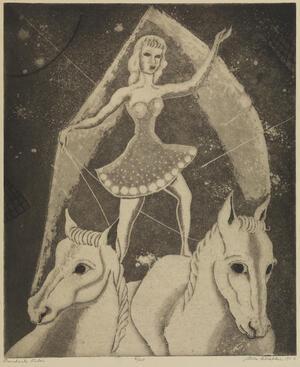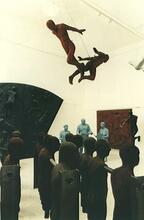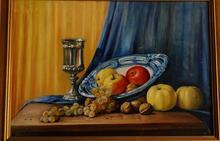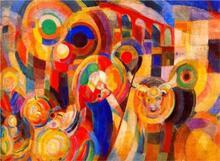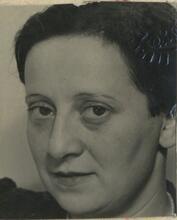Stella Drabkin
A talented painter and mosaicist who innovated new methods of printmaking, Stella Drabkin believed the mark of an artist was the ability to work in any medium. Drabkin worked as a commercial artist before studying at the Philadelphia Graphic Sketch Club, where she created a series of prints in the 1930s called Old Philadelphia. She was known for her experiments with multitype, a variation on monotype printing with layers of texture and color. She created biblical mosaics for the Philadelphia Free Library and played with the words, poetry, and pictures. Drabkin won first prize in the Gimbel Competition in 1933 and the New Jersey State Museum Purchase Prize in 1967. In 1972, the Art Alliance established the Stella Drabkin Memorial Award Fund in her honor.
In her 1938 self-portrait, Stella Drabkin depicts herself with extraordinarily large eyes, widened to take in the world. Some thirty years later, in a haiku to accompany the multitype Birds of Prey, she wrote, “The eye of the eagle sees what you do not … aware as the artist.” The application of the artist’s eye was the constant in Stella Drabkin’s varied undertakings as painter, printmaker, mosaicist, and author.
Personal Life and Career Successes
Born (Stella) Molly Friedman to Carlaman and Francesca (Seandel) Friedman in New York City, she worked as a commercial artist before attending the National Academy of Design in New York for one year. She was married on May 1, 1926, to Dr. David L. Drabkin, later chair of the department of biochemistry, Graduate School of Medicine, University of Pennsylvania.
In the early 1930s, the Drabkins moved to Philadelphia, and Stella Drabkin became integrally involved in the art community of her adopted city. She studied at the Philadelphia Graphic Sketch Club with Earl Sorter, an illustrator known for fine etchings of cityscapes. Drabkin herself did a number of prints of the street life of Philadelphia. For example, in Bargain Sale I and II, Pushcarts I and II, and Free Day at the Zoo, all from the 1930s series Old Philadelphia, she concentrated on depicting working-class, ethnic neighborhoods.
In 1933, shortly after Drabkin’s arrival in Philadelphia, she entered a painting in the Gimbel Competition. It was her inaugural exhibition outside of New York, and she was the recipient of first prize. Among other awards won over the years was the American Color Print Society Prize (1944), the Katzman Prize of the Print Club of Philadelphia (1955), and the New Jersey State Museum Purchase Prize (1967).
In an interview given in 1945 to Art Alliance Bulletin, Drabkin professed to have begun painting at the age of two. She also recalled the great pride and pleasure she felt when, in the first grade, her teacher held up her drawing for the class to admire. In the same interview, she reports having no favorite medium, stating that “an artist should work in various medi[a], depending on the ideas he intends to express.”
Experimental Art
Stella Drabkin’s work, both in process and in product, reflects a serious lifelong commitment to her art. Her career was marked by experimentation and technical innovation, particularly with the multitype. Multitypes were described by Drabkin as a development of the monotype, produced by printing multiple impressions and superimposing them one over the other, resulting in a variety of color, texture, and luminosity. Her early multitypes were made from glass plates, but by 1950 Drabkin was using plastic plates, enabling her to run first states through the etching process. Additionally, plastic plates allowed the combination of intaglio and relief methods. In the multitype process, the prints could go through twenty or more states.
Drabkin also experimented with tesserae, creating a series of mosaic panels on biblical themes. These panels are owned by the Philadelphia Free Library and were on exhibit there for a number of years. Although the art community in Philadelphia that Drabkin belonged to had a large Jewish membership, specifically Jewish subject matter is reflected in only a small portion of her work. Drabkin’s subject matter in the 1950s and 1960s included the biblical personages Enoch, Elijah, Joseph, Solomon, and David. Biblical women did not appear in this series. Drabkin also produced works titled Cabalist and Cabalist Drawings, though, for the most part, her work reflects the general subject interests common at the time: street life (1930s), self-portraits (1930s, 1940s), circus and mime (1950s), or nature, with haiku (1960s). Drabkin designed the 1966 UNICEF calendar. In 1969 Drabkin’s book, Prints with Poems was published.
Legacy
Stella Drabkin died on August 11, 1971. The following year, in 1972, the Stella Drabkin Memorial Award Fund was established, administered by the Art Alliance, in her honor.
Art Alliance Bulletin (March 1945).
Collins, J.L. Women Artists in America (1973).
Drabkin, Stella. Artist’s file. New York Public Library, and Philadelphia Free Library, and Print Department, Philadelphia Museum of Art.
Fielding, Mantle. Dictionary of American Painters, Sculptors, and Engravers. 2d ed. (1986).
Petteys, Chris. Dictionary of Women Artists (1985).
Who Was Who in American Art (1985).
WWWIA 6.

